| • CONTACT |
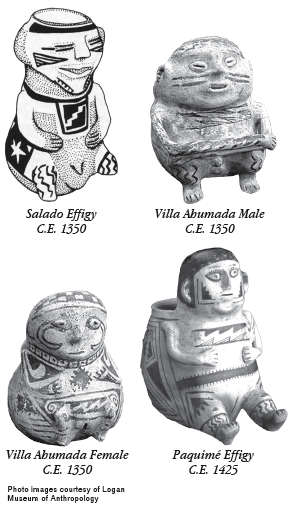
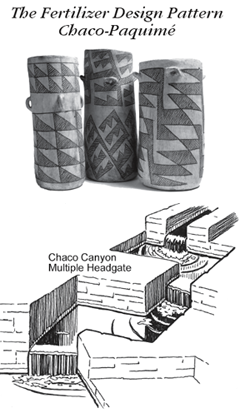
Chaco Canyon accentuated
“stepfret” design - At Chaco Canyon
the “stepfret” ceramic design is
very dramatic and sharply pointed.
I believe the black and white relief
symbolizes a dualistic universe,
male and female. I also suggest that
the very sharply angular stepfret
design used at Chaco is indicative of
male lightning which they associated
with fertile rainfall. At Chaco
the stepfret was primarily lightning
male and at other Anasazi locations
represented the more female 90
degree angle step (above).
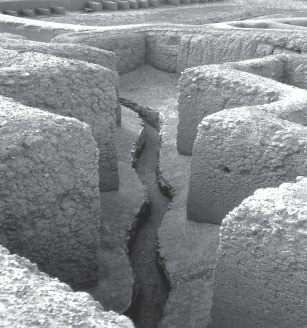
Paquimé stepfret design was
built directly into the
architecture of the site. The fact
that it is surrounding an
underground sewer line, I
propose, is evidence that it is the
design associated with naturally
occurring, as well as human
produced, fertilizer (above).
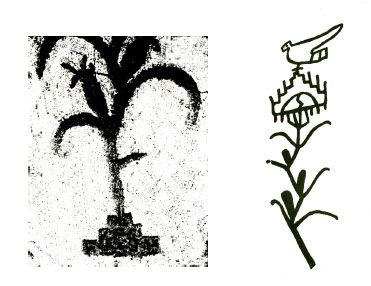


Three Rivers Rosetta Stone
(above)
C.E. 750-1000
Fertilizer Rosetta Stone Illustration Interpreted by Tarahumara Ethnographic Evidence: The Scarlet Macaw atop the corn stock represents the male sun god fertilizing the golden corn pollen. From this union comes the fertility of both the pollen as well as the stepfret fertility symbol at the roots. Male sky god with “stepfret” lightning legs. Hohokam Monumental art-female fertile rain attractor. Practical application is the making of fertilizer from a mix of rain associated with lightning and detritus/waste materials in what I now call a fertilizer dehydration basin Wupatki 14.4 by 28.3 meters (right)
Charles DiPeso
examines the obvious
male/femaile
relationship with the
Macaw enclosure
doorways. I propose
this is the basic
symbolism used for the
dualistic nature that
was revered by the Pre-Columbian Oasis
America cultures.
| Religious
Ceramic/Rock Art Architectural Design |
|
“Sky, clouds, lightning, precipitation and the wind - strong evidence that the associated beliefs concerned fertility and weather control. The icons thus provide evidence for the existence of an earth/fertility cult ... beliefs involving the well-being of the collective and the earth rather than the well-being of the individual and ancestors. ... This uniformity in design styles on a virtually pansouthwestern basis suggest that the design transcend whatever regional economic systems existed in the 1300s. It further indicates that designs masked rather than emphasized any economic or political boundaries extant at this time.” Ceramics and Ideology by Patricia L. Crown, Ph.D. Zuni symbolism indicates that “every design is significant ... , the tendency at Zuni to invariably associate decorative designs with ideas of a religious character. This is not a personal peculiarity of one woman, but is a general pattern of Zuni thought. ... An overwhelming number of designs suggest clouds of different kinds, – rain, snow, wind, lightning, flowers ‘because they come out after the rain.’” The Pueblo Potter by Ruth L. Bunzel, Ph.D. Stepfret and spiral designs throughout the Anasazi world and well beyond demonstrate similar religious belief systems. The designs can be seen as similar to the yin/yang concept of Oriental religions; the Tarahumara culture explains them as a male/female relationship. The Tarahumara religious and cultural concept of stepfret and spiral design patterns is in fact so simple as to be almost painful. Their belief system is that the universe and the earth are made up of two essential components-male and femalewhich fit together in an exactly matching cosmic unity. These designs demonstrate the weight of their significance throughout the Oasis America culture by the fact they were reproduced perhaps many millions of times on ceramics as well as in massive architecture as seen at Paquimé and perhaps Zuni. Along with Scarlet Macaws and many other common features, these designs can be seen to indicate a shared religious belief system throughout the region and throughout the 250-plus year time frame from Mesa Verde in the north to Paquimé in the south. Other theories proposed include: this design has no specific meaning; it is a simple cloud pattern; it originates from the basket weave designs of 400 years earlier.
Paquimé archaeologist (Charles DiPeso) is shown (right) with anthropomorphic male “plug” from the stone birth canal of the ceremonial macaw birthing chambers. These enclosures have been previously interpreted as macaw nesting boxes. It is noted, however, that macaws are very unlikely to breed and nest under the conditions illustrated in the lower right photographs. The original interpretation given here is that the macaws exit mother earth during major religious ceremonies, most likely at the spring equinox. As they walk into the light they are lifted by the priest to greet the father sky. The “macaw stones” or doors to parrot pens show an isomorphic patterning with ballcourt distribution (Whalen and Minnis 1996). Our interpretation is that many of the architectural structures identified as “ballcourts” are actually fertilizer dehydration basins. The macaw stones were used as water control devices in this context and also have the religious connotation of releasing the fertile water, thereby completing the rainwater/fertility cycle for the corn crop. This is a completely new concept, and as far as is known, the actual layout and design of the fertilizer dehydration basin relating to the macaw stone cannot be understood without further study.
|
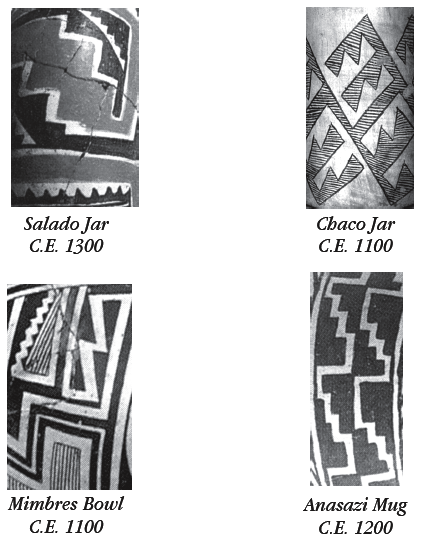

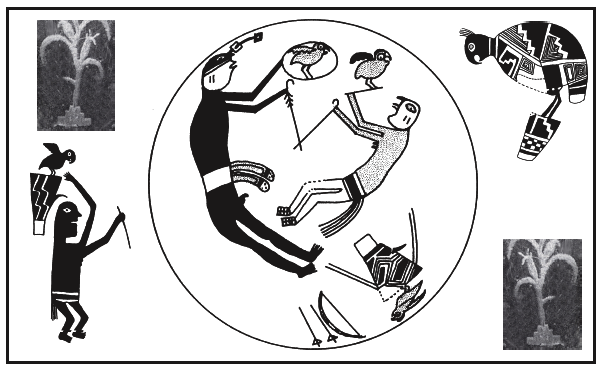 The Mimbres polychrome representation (above) shows the
“vision quest” sky deity delivering the macaw in an enclosed
seed casing through the “staff(s) of authority” to the earth female
deity, as the macaw enters the natural sphere of existence. Notice
the strong stepfret design pattern associated with the separate
The Mimbres polychrome representation (above) shows the
“vision quest” sky deity delivering the macaw in an enclosed
seed casing through the “staff(s) of authority” to the earth female
deity, as the macaw enters the natural sphere of existence. Notice
the strong stepfret design pattern associated with the separate